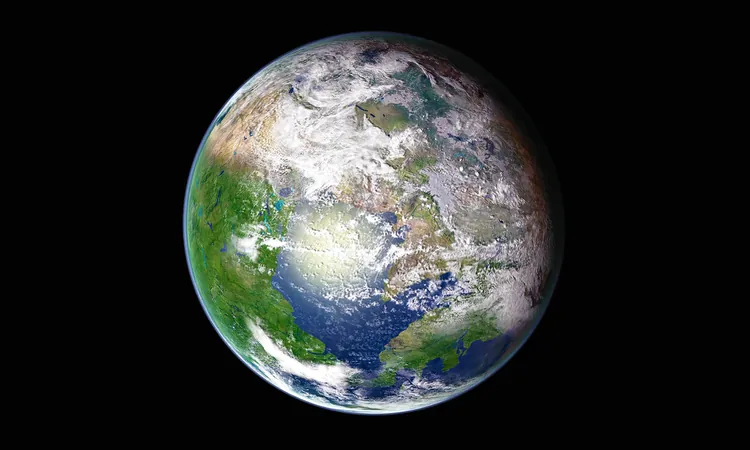
Are We Facing the Next Great Extinction? Scientists Reveal Shocking Predictions for Humanity and Mammals
2024-11-03
Author: Siti
The Rise of Pangea Ultima
The research highlights the possibility of Earth's continents gradually reuniting to form a colossal supercontinent, dubbed Pangea Ultima. This new landmass could greatly disrupt the planet's climate, potentially creating an environment inhospitable to most life forms.
Using advanced supercomputer climate models, the study predicts that this new continental configuration could generate extreme heat and dryness, far beyond our current experiences. Dr. Farnsworth outlines a daunting 'triple threat' scenario driving this future devastation:
Continentality Effect
The emergence of a vast landmass would distance many regions from the cooling influence of oceans.
Increased Solar Radiation
Over the ages, the sun is projected to become brighter, releasing more energy and contributing to global warming.
Volcanic Activity and Carbon Dioxide Surge
Tectonic shifts are expected to accelerate volcanic activity, releasing massive amounts of CO₂ into the atmosphere, further intensifying the greenhouse effect.
According to the study, humanity could face relentless temperatures reaching between 40 to 50 degrees Celsius (104 to 122 degrees Fahrenheit). These conditions would challenge our very survival, especially given the limitations of mammals to regulate body temperature through sweating.
Mammals on the Brink
Historically, mammals have adapted to a range of harsh climates, evolving features such as fur for warmth and the ability to hibernate. However, the study warns that under the prospective conditions of Pangea Ultima, only 8% to 16% of land would remain hospitable for these species. With food and water prerequisites becoming increasingly scarce due to extreme heat and aridity, survival will become a near impossibility.
Immediate Climate Crisis vs. Distant Predictions
While this catastrophic scenario unfolds millions of years into the future, researchers urge immediate action to address today's climate crisis. Co-author Dr. Eunice Lo emphasizes that current human-induced emissions of greenhouse gases are already causing extreme heat events detrimental to health. 'Reaching net-zero emissions is desperately crucial if we wish to avert dire consequences for life on Earth,' she insists.
The study estimates that current CO₂ levels at around 400 parts per million could soar to over 600 ppm in the geological future, pending human activity. The potential trajectory suggests a future environment ravaged by heat and harsh living conditions.
Beyond Earth: Implications for Exoplanets
This research also prompts significant questions regarding extraterrestrial life. Dr. Farnsworth notes that the findings could aid scientists searching for life on other planets by revealing how changing continental configurations affect habitability. 'A so-called habitable zone in a solar system might not be suitable for human-like life if its continents are gathered together,' he concluded.
Lessons from History
Our planet has seen several mass extinction events throughout its history, often triggered by radical environmental changes. These include the Permian-Triassic extinction event—known as 'The Great Dying'—and the Cretaceous-Paleogene event caused by an asteroid impact. Each disaster reshaped life on Earth and serves as a critical reminder of our planet's fragility.
As we adapt to changing environmental conditions today, we must remember that we share our home with countless other species, all of whom face similar threats. Understanding past extinctions can galvanize efforts to mitigate our current trajectory toward irreversible climate damage.
Conclusion
In summary, the study offers a sobering glimpse into the future where humanity's existence may hang by a thread amid unforgiving heat and scarcity. The message is clear: we must act swiftly to secure a sustainable future for ourselves and all of Earth's inhabitants.
Stay tuned for more updates on climate science and our ever-evolving planet!



 Brasil (PT)
Brasil (PT)
 Canada (EN)
Canada (EN)
 Chile (ES)
Chile (ES)
 España (ES)
España (ES)
 France (FR)
France (FR)
 Hong Kong (EN)
Hong Kong (EN)
 Italia (IT)
Italia (IT)
 日本 (JA)
日本 (JA)
 Magyarország (HU)
Magyarország (HU)
 Norge (NO)
Norge (NO)
 Polska (PL)
Polska (PL)
 Schweiz (DE)
Schweiz (DE)
 Singapore (EN)
Singapore (EN)
 Sverige (SV)
Sverige (SV)
 Suomi (FI)
Suomi (FI)
 Türkiye (TR)
Türkiye (TR)